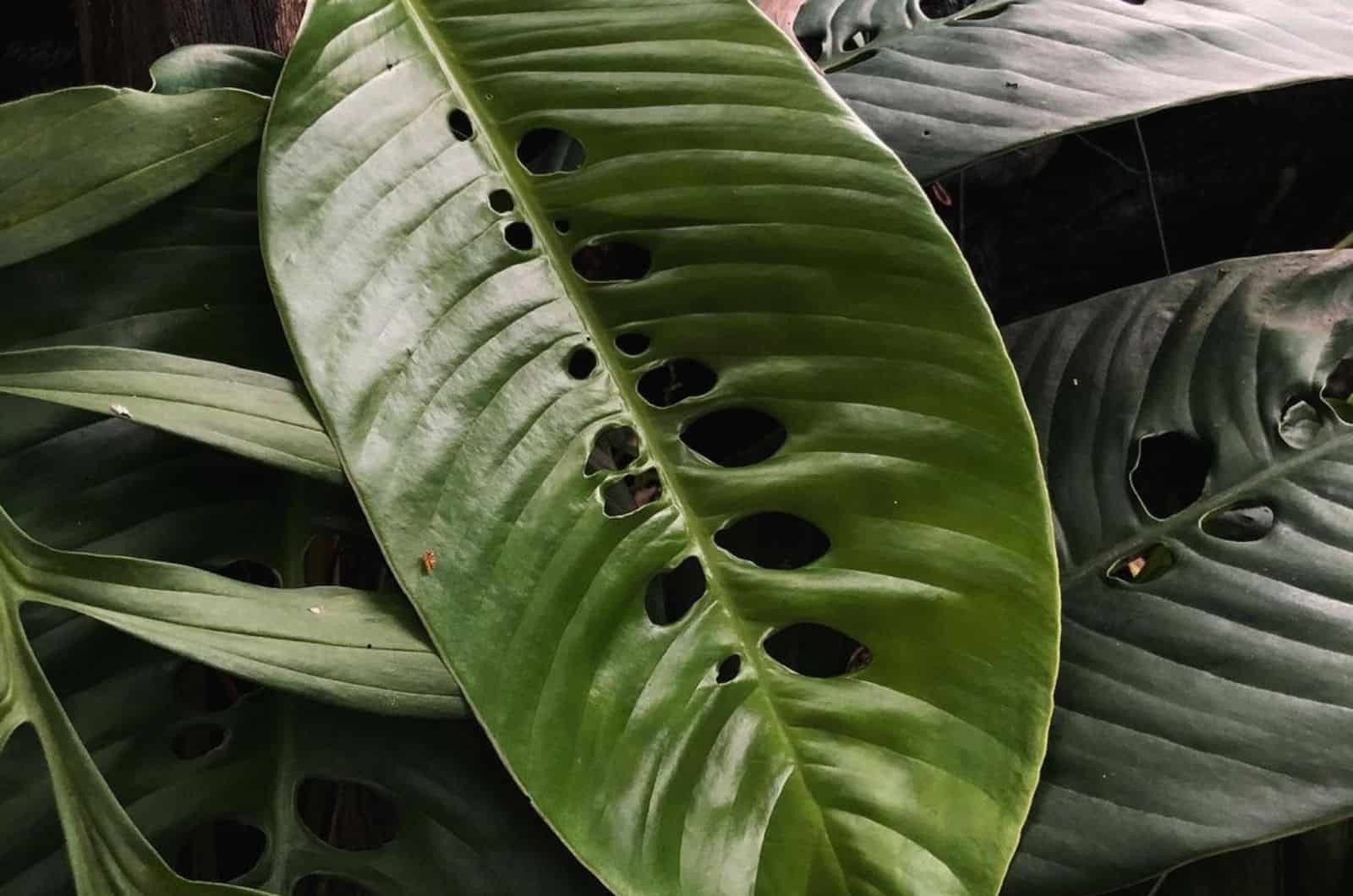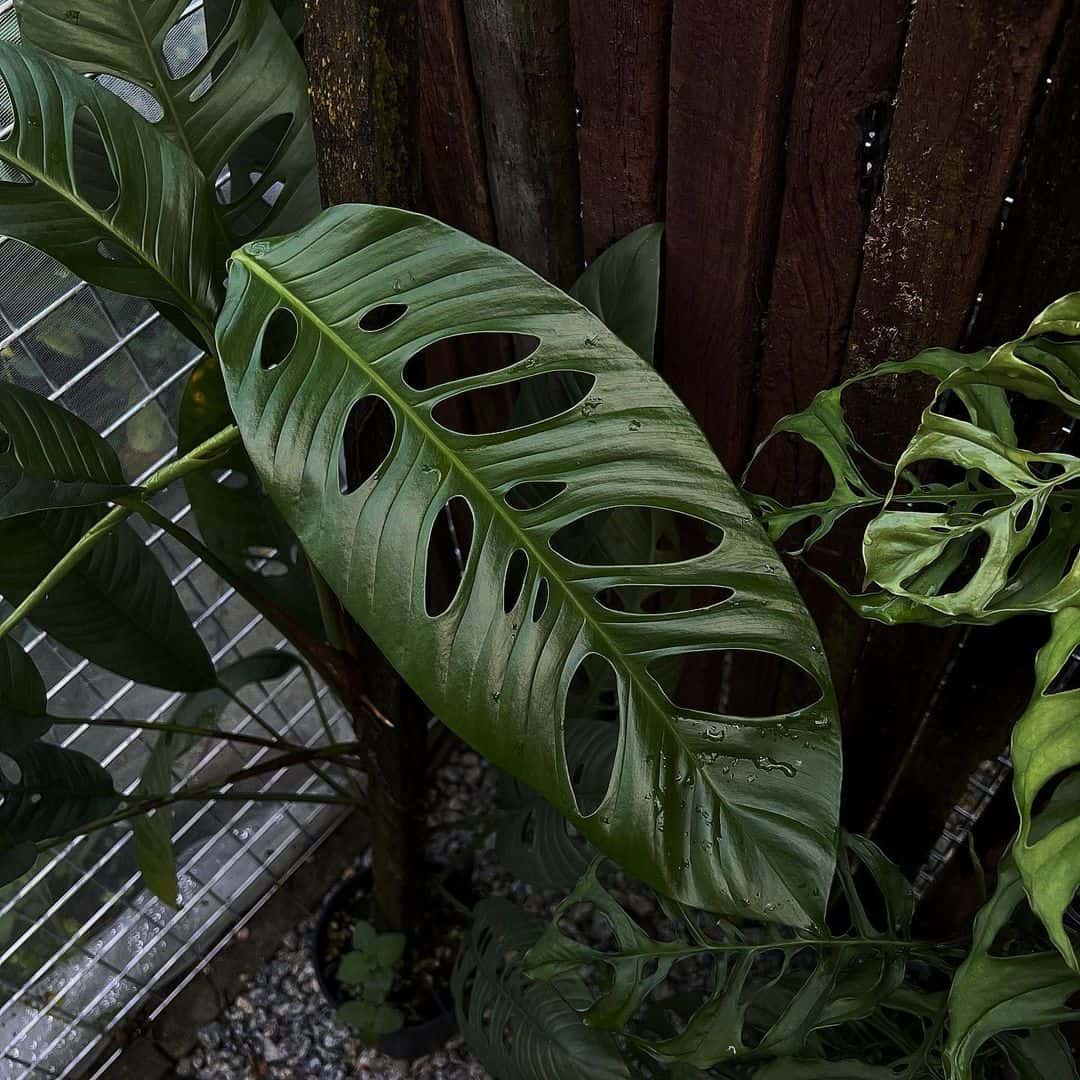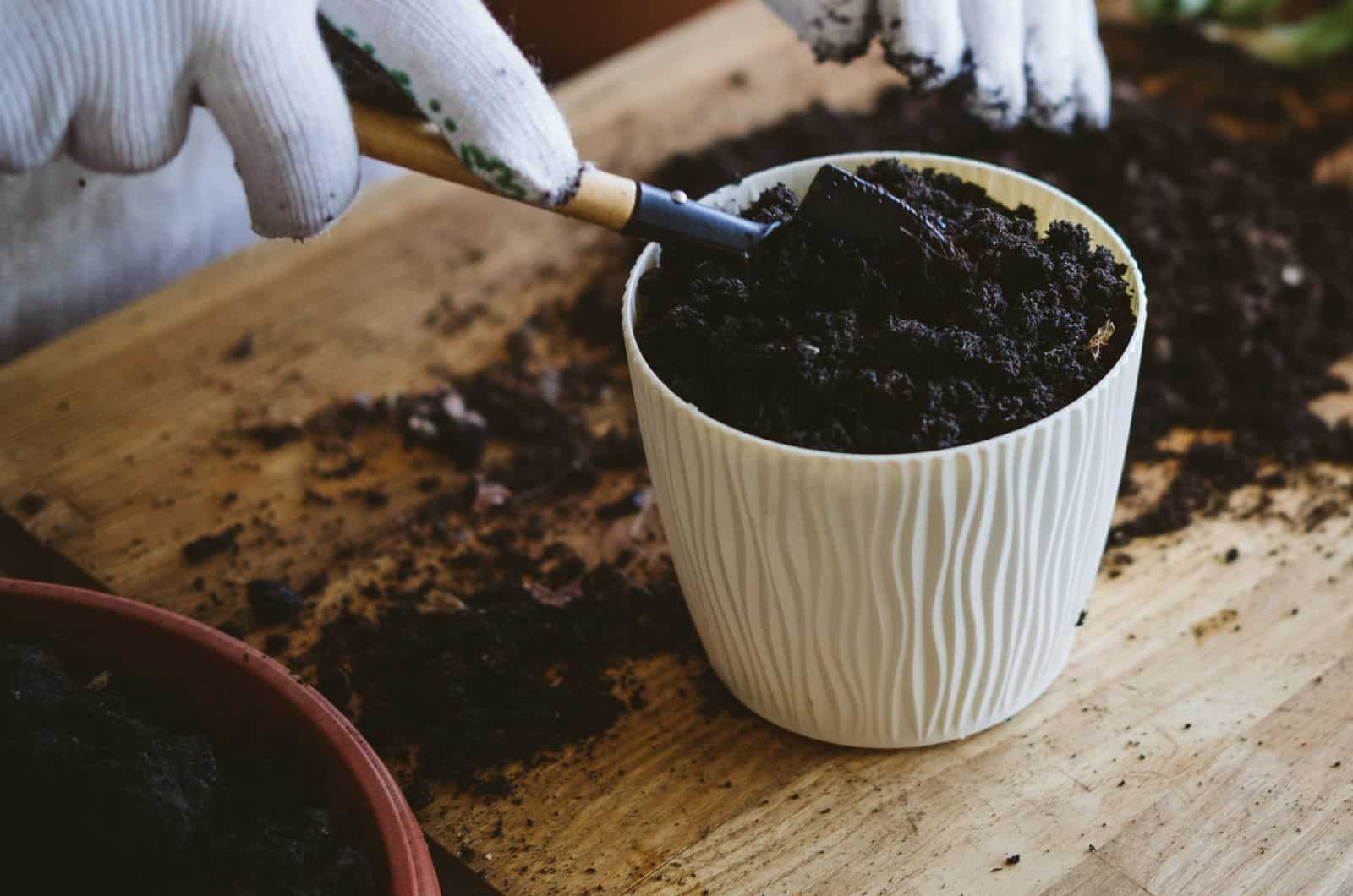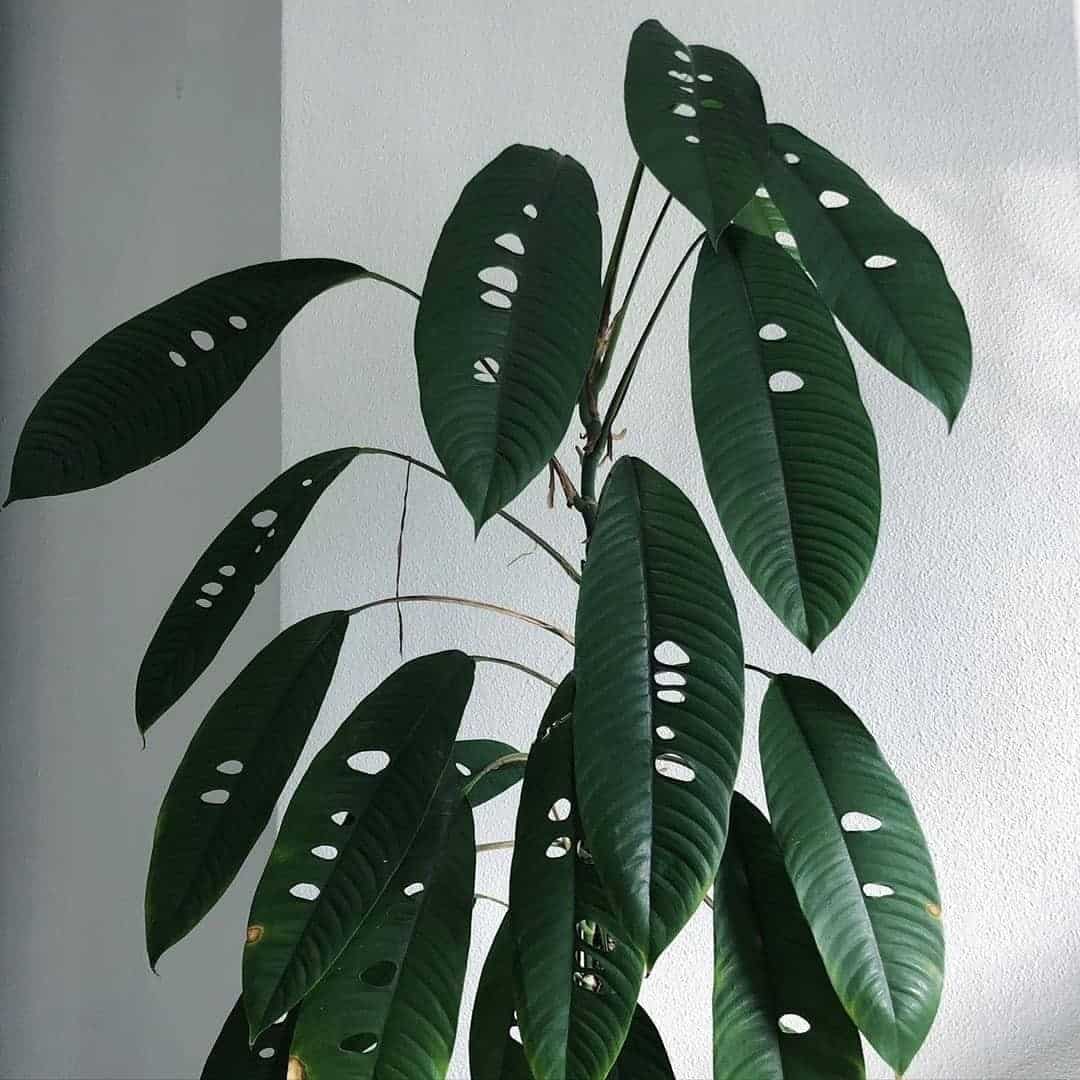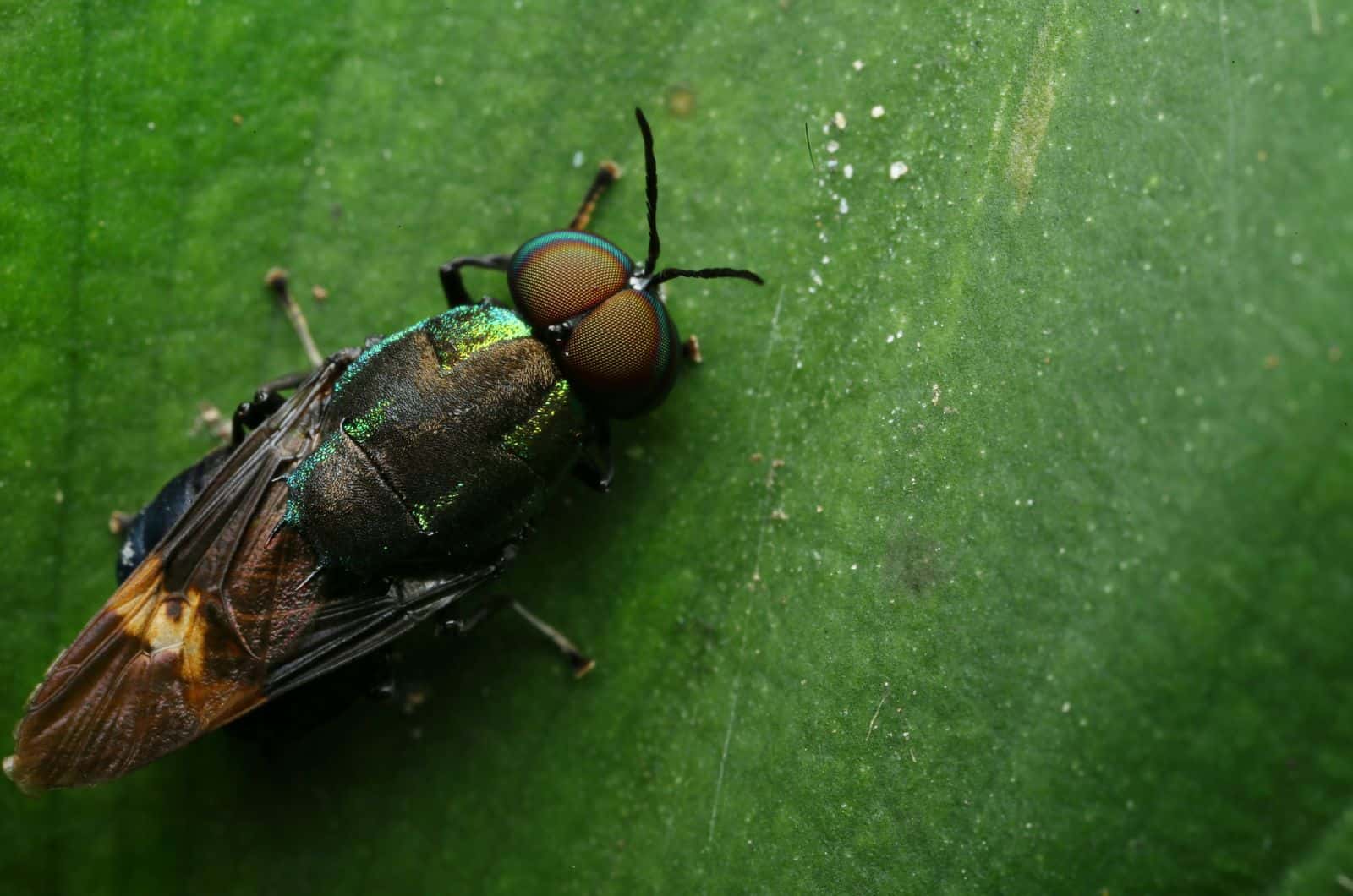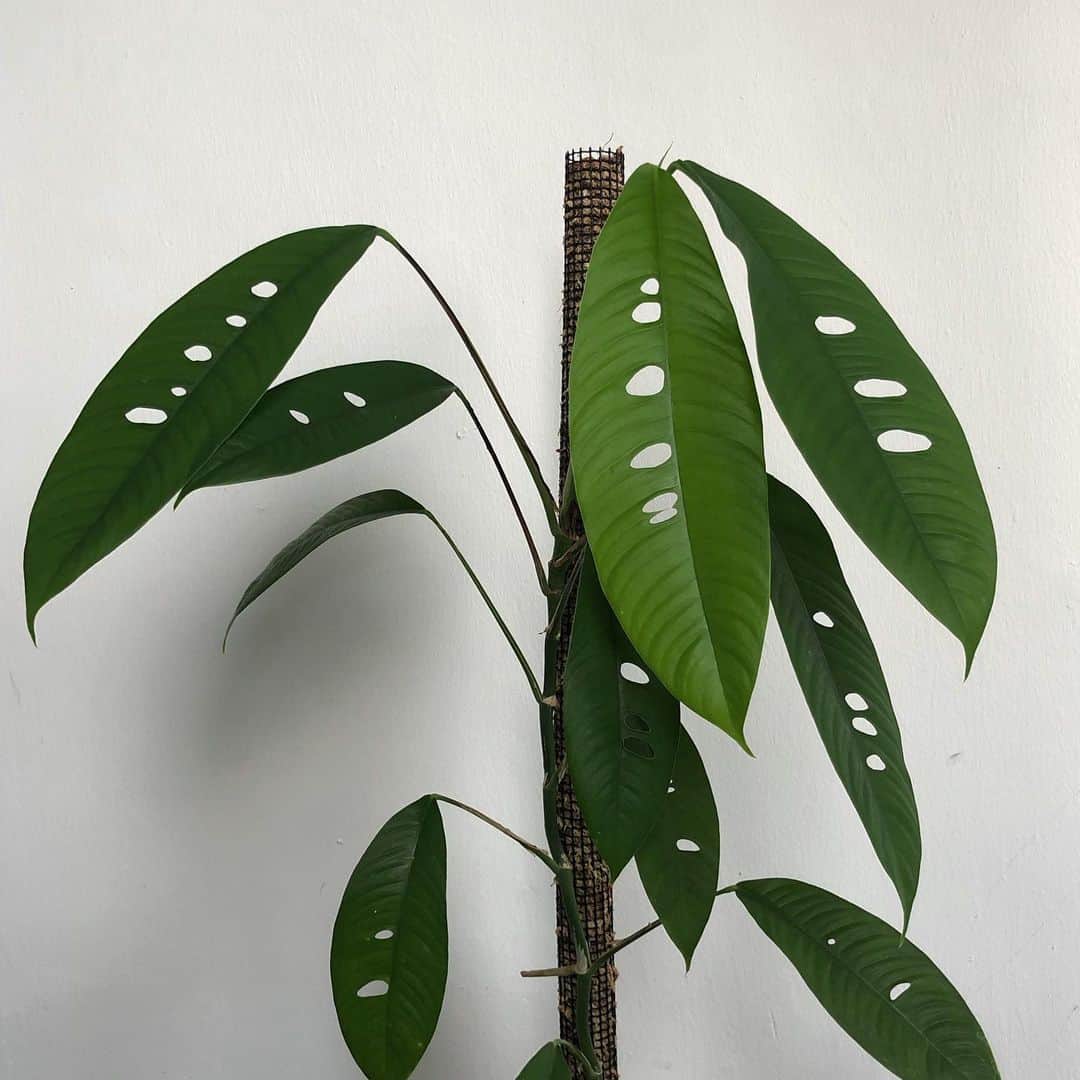Some plant names sound complex, and it seems like they don’t portray the true beauty of the plant.
That’s why we give them nicknames; because gardening is more about activity than learning Latin. If you are a beginner, sooner or later you’ll realize that a complicated name doesn’t have to mean a complicated plant.
I would like to show you the Rhaphidophora foraminifera, a rare plant whose name comes from Latin. Due to its beauty, this Rhaphidophora is becoming increasingly popular.
It’s a low-maintenance plant, and its unique shaped and structured leaves make it desired by many.
I’ll tell you more about its features, types, care guide, propagation, and common issues, so I’m sure that after reading this article you’ll want to try and find a foraminifera plant for yourself.
Here’s some basic info about this plant:
[table id=435 /]Let’s get started!
What Is A Rhaphidophora Foraminifera?
Photo from: @araceae_
The Rhaphidophora genus includes many stunning plants, such as the Rhaphidophora decursiva, Rhaphidophora korthalsii, and Rhaphidophora hayi.
Although Rhaphidophora plants resemble Monsteras and Philodendrons, they have unique features that make them the perfect addition to plant collections.
Some Rhaphidophora plants look almost the same as Monsteras, such as the Mini monstera aka Rhaphidophora tetrasperma.
Foraminifera plants are climbers, so training them or growing them in hanging baskets will only add more beauty.
It’s time to find out what this plant looks like, how fast it grows, and its growth habit.
Let’s begin!
Appearance
I am going to tell you more about the leaf shape and structure, stems, flowers, and fruits of this plant.
Let’s learn how to identify the foraminifera plant.
Leaves & Stems
The Foraminifera features elongated green leaves that can have many circular or rhombic perforations that span up to 1/4 of either side of the leaf surface.
However, juvenile leaves are complete and have hairs over the surface that change color as they age.
Their silky, green stems have leaf scars that are either somewhat oblique or straight.
This Rhaphidophora also features thick aerial roots.
Flowers & Fruits
The inflorescence is usually covered with one or two enormous cataphylls that swiftly dissolve to a black mucilage. The mucilage may stick to the developing spathe once it dries.
The light or dark yellow, canoe-shaped spathe remains in that state until it reaches maturity.
Fruit is dark green in the early stages of development, and turns greenish-yellow once it matures.
Growth Rate & Habit
The foraminifera plant is a liana, and originally grew on hills or rocks.
It grows quickly and can reach lengths of 49 feet. In contrast, it might not grow as long indoors, and rarely ever any longer than 8 feet unless grown outside.
If you decide to grow a foraminifera as a houseplant, you’ll need to provide it with support.
Variegated Rhaphidophora Foraminifera
The Epipremnum foraminiferum plant also comes in variegated versions. You can find R.foraminifera, albo variegata, and R.foraminifera mint variegata.
The most prevalent variety is mint variegata. This lovely plant features brilliant, light green striping, spots, and sections on its green, perforated foliage.
If you’re interested in buying this Rhaphidophora plant, you better start saving your money!
Believe it or not, a single cutting of this plant might cost you $300, whereas an established plant may cost you about $1,500.
The foraminifera albo variegata plant is rare, and this variegated version features creamy or white stripes, spots, or portions on the leaves.
This Rhaphidophora plant will cost you from $300 to $600.
Rhaphidophora Foraminifera Care Guide
The R.foraminifera is a tropical plant, which means it’ll need slightly different conditions than those found in typical households.
Here is a table with an overview of the basic requirements of the foraminifera plant:
[table id=436 /]Let’s get into details!
Light Requirements
No plants that grow as climbers in their natural environment receive direct sunlight. These Rhaphidophora are typically protected by the dense foliage of taller trees, which means intense sun rays can’t reach them.
If you grow this Rhaphidophora indoors, you’ll need to keep it away from direct sun unless you want the leaves to scorch, turn yellow, and get sunburned.
The best light for the foraminifera plant is bright indirect light. The plant has adapted well to many conditions that differ from those found in its natural habitat, but when it comes to light you’ll need to be careful.
Direct sunlight isn’t an option, and you’ll also need to be careful about low light.
As mentioned, this is a fast-growing Rhaphidophora, and if you don’t provide it with enough light it will grow slower or sometimes even stop growing altogether.
An appropriate light level is essential for variegated foraminifera plants. These plants don’t perform photosynthesis in the same way as standard due to the lack of green color, so you’ll need to provide more bright light to help the plants grow healthy and preserve color.
Getting grow lights is a great idea for rooms that don’t get enough light. If your foraminifera is too close to a window with direct sun, protect it by putting up sheer curtains.
Humidity Requirements
Another essential factor of foraminifera plant care is the humidity level. This plant is an aroid, which means you’ll need to ensure humidity that’s higher than found in a typical household.
If you decide to grow this Rhaphidophora plant indoors, you’ll need to ensure at least 50% humidity.
I assume that humidity isn’t this high in your home, so I recommend boosting it by using one (or more) of the methods for increasing humidity below.
Mist The Leaves
Misting plant leaves is a tried-and-true technique for raising humidity levels. This approach will be quite effective if you can do it regularly.
You should spray your foraminifera plant several times each day. If you don’t have that much free time, I would combine this method with one of the others below.
Move Your Rhaphidophora To A More Humid Room
If your plant looks brilliant in your living room but struggles to grow because of low humidity, you don’t need to increase the levels, just move your foraminifera to a more humid room.
Places in our homes that have water sources, i.e., kitchens and bathrooms, have more moisture in the air due to water evaporation.
Create A Microclimate
Some growers keep all their plants in one room. Interestingly, this often has nothing to do with appearance but is beneficial for plants in terms of humidity.
If you grow your foraminifera near other houseplants such as Monsteras, Philodendrons, and Anthuriums, you will make a microclimate and increase humidity levels.
Use A Humidity Tray
A very common way to increase humidity is by placing a humidity/pebble tray below the pot.
You can take a tray, add some pebbles, and fill it with water to increase water evaporation, i.e., moisture levels.
Install Humidifier
Many growers, especially beginners, don’t like to experiment with humidity. Instead, they go with the safest option of a humidifier.
This is the safest option, but remember they can be pretty expensive and sometimes require maintenance. I guess that’s the reason why we have so many DIY versions!
Temperature Requirements
Although it may seem like the foraminifera plant needs very high temperatures due to its native habitat, that’s not strictly the case.
Your Rhaphidophora enjoys average household temperatures between 70 to 80 degrees Fahrenheit, but slightly lower or higher doesn’t impact the growth.
The only problem is the outdoor temperature, so if you grow this Rhaphidophora outside you’ll need to be careful and move it inside if the temperatures ever drop below 50 degrees Fahrenheit.
You should avoid placing your foraminifera plant near devices in your household that emit heat like radiators, heating vents, or similar devices, which will do harm to your precious plant.
Soil
When choosing the potting mix for your foraminifera plant, pay attention to three factors: drainage, soil fertility, and aeration.
A soil blend for aroids will fulfill the needs of this Rhaphidophora plant.
You can purchase this soil mix online, at plant stores, or make it yourself.
If you decide to make a potting mix for your foraminifera, you’ll need a couple of materials.
For example, you can use perlite or pumice for drainage, coco coir or peat moss for good water retention, coco husks for aeration, and compost for fertility.
As far as the pH level is concerned, you can either go with neutral or slightly acidic (6.1 to 6.5).
Watering
The foraminifera plant thrives in moist soil, so you’ll need to water it more often than other common houseplants.
You’ll need to be very careful not to overwater this Rhaphidophora as it’s extremely susceptible to root rot.
You can avoid waterlogging and ensure enough soil moisture at the same time by checking the soil moisture content before you water your plant.
It would be way easier to set a reminder every Wednesday to water your plant, but this won’t work and it could even be lethal.
You’ll need to check the soil each time you water to measure the moisture content. Generally, the soil should be dry two inches below the surface.
Here are a couple of ways to tell if your Rhaphidophora needs water:
1. Put your finger in the soil: A pretty quick and effective way to check moisture is by putting your finger in the soil, and if the soil feels dry, give your foraminifera a good soak.
2. Observe soil color: Soil color will also help you with moisture detection. When you water things, their color grows darker; and the same goes for soil. If it’s light brown, it needs water.
3. Use a moisture meter: If you aren’t sure about the methods above, you can buy a moisture meter, which is the most precise method of moisture detection.
Watering Frequency
You’ll need to check the soil moisture more frequently during hot summer days.
High temperatures will increase the water evaporation rate, which means your foraminifera will need more water.
On the other hand, lower temperatures decrease the water evaporation rate, which in turn lowers the foraminifera’s need for water.
During the winter, your foraminifera will be in dormancy, so it won’t need much water.
As the growing season approaches, you’ll need to increase the watering frequency.
Watering Technique & Water Type
The best water type for plants is what they receive in their natural environment, i.e., rainwater. If you can’t collect it, you can go with filtered water instead.
If you decide to use tap water for your foraminifera, let it sit overnight so that harmful chemicals evaporate.
When watering your Rhaphidophora from the top, avoid watering the leaves, and don’t spare water because underwatering may lead to dehydration and other issues.
Fertilizing
Foraminifera plants aren’t heavy feeders. You’ll need to fertilize them monthly, but only during the growing season.
As soon as fall arrives, cut back on feeding entirely.
The best fertilizer type to use for foraminifera plants is balanced, all-purpose, and liquid plant food.
I recommend diluting the solution to half strength in order to avoid fertilizer burns.
Pruning
Luckily, you won’t need to spend much time pruning this Rhaphidophora plant. Of course, if you don’t like the shape or the way your plant has grown, feel free to cut off any unwanted branches.
Please use sanitized shears when pruning your foraminifera to avoid contamination.
If you notice that the leaves have changed color (yellow, brown) or are deformed (crispy, wavy), you can cut them off.
Repotting
The foraminifera plant is considered to be a fast grower, so you’ll need to repot it more often than other common indoor plants.
You can repot it every spring, but if your foraminifera isn’t rootbound you can skip repotting and check the root system next year.
When repotting, carefully remove your Rhaphidophora from its pot and clean away the potting soil around the roots.
Check if there are any issues with the roots, and if they’re mushy, black, or brown you’ll need to remove them because your foraminifera plant is most likely suffering from root rot.
Use clean cutting tools and spray fungicide over the root system after you remove the diseased roots.
Use a new pot (2 inches larger in diameter) and fresh potting mix. Put your foraminifera in the new pot carefully and water it thoroughly.
Staking
If you grow other climbing houseplants, I’m sure you’ve noticed that they grow better when staked.
You can use a lot of different supporting structures for your foraminifera, such as a moss pole or similar tools.
How To Propagate A Rhaphidophora Foraminifera
Photo from: @sanso_la
You can propagate your foraminifera plant by using stem cuttings, and you can either root the cuttings in water or soil.
I’ll show you both ways today, and don’t worry because propagating Rhaphidophora plants isn’t difficult and the stem cutting method has a high success rate.
Take The Cuttings
Before taking foraminifera stem cuttings, make sure your plant is healthy. Then prepare a sharp knife, sanitizing solution, and a rooting hormone.
Here are the steps for taking foraminifera stem cuttings:
1. Select a healthy foraminifera stem with at least two nodes.
2. Make a clean incision below the lower node. If there are any leaves on the lower part of the cutting, I recommend removing them as they could rot if planted in soil or immersed in water.
3. Apply rooting hormone on the cutting to encourage sprouting.
Root The Cuttings
As mentioned, rooting the stem cutting can be done in either soil or water.
Rooting In Water
Although water propagation isn’t a must, I recommend it for beginners.
You’ll need to prepare a transparent container and some water.
Here are the steps for rooting foraminifera cuttings in water:
1. Pour fresh, room-temperature water into the selected container.
2. Submerge the foraminifera cutting in water, making sure that all of the leaves are above it.
3. Place the container somewhere it can get enough bright indirect light.
4. Don’t forget to refresh the water every two to three days.
You can expect the foraminifera cutting to display new growth after about a month.
Rooting In Soil
Another option for rooting the stem cuttings is planting them directly in the soil.
Here are the steps:
1. Add fresh soil mix to the new pot.
2. Make a hole deep and broad enough to accommodate the cutting.
3. Insert the foraminifera cutting in the soil, making sure one node is below the soil surface.
4. You can cover the cutting with a plastic bag, but don’t forget to make a hole to allow air to circulate properly.
5. Put the cutting in a warm and well-lit spot.
Transplant The Rooted Cuttings
The cutting needs to be transplanted once it develops 2 inch long roots. You’ll need to be very cautious with new roots, especially if you are propagating in water.
Fill a pot with potting mix (you can find a good recipe above) and insert the rooted cutting.
Your new plant will now need usual foraminifera care.
Common Issues
Although many growers claim that Rhaphidophora plants are problem-free, they do face some issues.
Pests, diseases, and problems related to inadequate care are the most common.
Let’s find out more.
Pests & Diseases
Remember that if one of your plants has pests, they can easily spread to all your other plants.
The foraminifera plant can be inhabited by a few pests, including spider mites, scales, aphids, mealybugs, and fungus gnats.
There are a few ways to control pests during flowering, including insecticidal soap, neem oil, and rubbing alcohol.
You can also get rid of plant flies quickly by using fly traps.
Although rare, fungal or bacterial diseases can occur. If your foraminifera suffers from bacterial leaf spot, you’ll notice dark lesions all over the plant.
On the other hand, the most common fungal disease that attacks foraminifera plants is root rot. Yellow and brown leaves, mushy soil, a bad smell, and discolored roots are the most common root rot disease symptoms in the foraminifera plant.
Leaf Discoloration
If the leaves of your foraminifera plant turn yellow, you’ll need to check if it’s receiving too much or too little light, if it’s overwatered, or if it lacks any nutrients.
The tips and edges of foraminifera leaves may turn brown. If this happens, you need to check the light level, see if the plant is dehydrated (underwatering), or if you have added too much fertilizer.
If the leaves develop brown blotches, your foraminifera is most likely overwatered or suffering from a pest infestation.
Curling, Wilting, Drooping
The most common cause of leaf curl, wilting, and drooping is underwatering.
If the temperatures and humidity are too high, or your plant is getting too much bright light, it will most likely start developing curly leaves and start wilting and drooping.
The best idea would be to adjust all the conditions and water your plant more often until it recovers.
FAQs
Photo from: @araceae_
Is the Rhaphidophora foraminifera toxic?
Yes, all parts of the Rhaphidophora foraminifera are toxic because they contain calcium oxalate crystals. Once a pet or child consumes any part of the foraminifera plant, it will release the crystals and lead to irritation, swelling, and loss of appetite.
Cats and dogs may also have difficulty swallowing.
What is the lifespan of a Rhaphidophora foraminifera?
The Rhaphidophora foraminifera, aka Epipremnum foraminiferum, is perennial, which means that its lifespan is longer than two years.
If you meet all the requirements, it can grow healthily for a few years.
Wrapping Up
Growers love rare plants, and having at least one in their collections is essential. If you would like one, you should try to find a Rhaphidophora foraminifera.
It’s a low-maintenance plant, and its amazing, elongated leaves with holes along the midrib will look great in any room.
The only disadvantage of the foraminifera plant is its toxicity, so if you decide to grow one, you must make sure it’s out of reach of small children and pets.
Lastly, if you manage to get this Rhaphidophora, don’t forget to propagate it!
Until next time!

